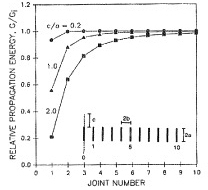| |||||||
|
|
|||||||
|
|
|||||||
| Mechanisms and Mechanics of Joint Sets | |||||||
|
There are several factors supporting or enhancing formation of a joint set rather than a single runaway joint. First, multiple flaws distributed throughout a rock volume. Hence at the initiation of a joint array or during its evolution there are numerous individual joints competing for the opportunity for the next incremental growth. Second, stress relief or stress shadow around a joint resulting in a highly heterogeneous stress distribution such that other joints can only develop outside the immediate sphere of influence of an incipient joint. As shown by Lachenbruch (1962), formation of a joint releases stresses perpendicular to the joint in a region whose lateral dimension scales with joint height (Figure 1). This concept provides a basis for estimating the distance from an existing joint by which another joint can form and is relevant to how joint spacing is related to the joint height or layer thickness. A similar argument can be made for an array of joints growing away from a surface (Figure 2). If one of the joint elements advances by a small increment, this reduces the propagation energy available for the nearby joints and this reduction is proportional to the amount of increment and inversely proportional with the distance from the joint with the growth increment (DeGraff and Aydin, 1993). Interested readers may also want to see Pollard and Aydin (1988), and Nur (1982), the latter of which focused on lineaments primarily based on geomorphic expressions. As we pointed out earlier, interaction among neighboring joints and their propagation velocity are important factors in influencing joint set properties. | |||||||
| Reference: |
|||||||
| DeGraff, J.M., Aydin, A., 1993 Lachenbruch, A.H., 1962 Nur, A., 1982 Pollard, D.D., Aydin, A., 1988 |
|||||||
|
Readme | About Us | Acknowledgement | How to Cite | Terms of Use | Ⓒ Rock Fracture Knowledgebase |
|||||||

